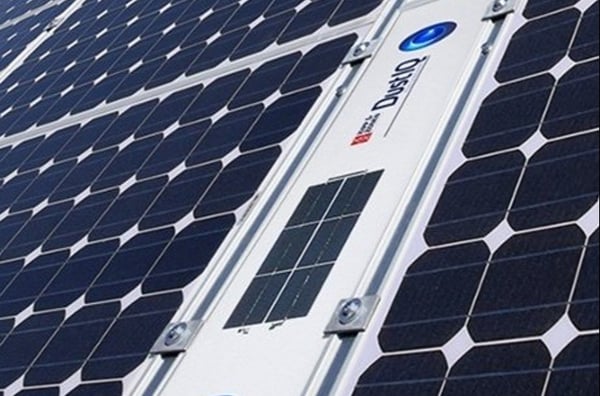Site capacity is one of the major factors that drives the total cost of a SCADA system for a solar or energy storage project. However, it is not the only factor—and intelligent site design can help mitigate several of these factors to reduce short and especially long-term SCADA costs.
Let's look at how to do that.
First, it's vital to understand point count (tag count) and how it affects SCADA costs.
A point or tag is a packet of data that holds a value, such as a measurement reading, tracker position, inverter data, or a triggered alarm. Each device at a solar PV site (meters, inverters, trackers, MET sensors, etc.) has a set of data points that the SCADA system pulls in. From there, the data can be monitored on HMI displays, logged, and stored by the SCADA historian.
As the number of data points or tags goes up, so does your project cost:
- You need more processing power and hard drive capacity to handle and store the data, meaning higher hardware costs. If the system gets overloaded, you're potentially looking at costly downtime and troubleshooting.
- It takes more hours, and therefore higher labor costs, from the SCADA provider to integrate all of the data points and map them into the HMI.
- The licensing cost of SCADA, historian, and HMI software is typically tied to point or tag count—the higher the tag count, the higher the cost.
One of the best ways to cut down on SCADA project costs is to be strategic about how many data points you pull into your system. As we'll cover in more detail, some types of devices and SCADA site designs have more data points than others. You can also limit the data points that are actually historized and displayed on the HMI.
Our article on Maximizing Your Historian Investment has more information on this process.
How can choosing the right tracker design help reduce SCADA costs?

Tracker systems account for a large portion of the hardware costs in a solar PV project. They also have a major bearing on the cost of the site's SCADA system due to the large amount of data they produce. The tracker controllers, motors, and sensors can add a tremendous number of data points that drive up hardware, software, and integration costs.
However, there are ways to mitigate this through intelligent site design and making strategic decisions about the data you choose to monitor.
Consider Motor & Controller Count
Some tracker systems have only a handful of motors that control multiple rows of panels each, while others have one motor per row of panels. The latter option can easily add thousands of motors—each with multiple data points—for a large-scale utility plant.
The tracker controllers also contribute data points. Some tracker systems have one controller per inverter pad, while others have two or more.
Do I Really Need to Monitor Every Bit of Data?
Some tracker controllers are more complex than others, and have the ability to provide extremely granular data. This data might be very valuable depending on your unique needs and setup. However, the temptation is often to pull in every bit of available data into the SCADA system simply because it is available.
Carefully weigh the value of this granular data against the extra cost. Knowing the tilt per row may be helpful, but might not be worth adding the extra data points to your system. Consider which points are absolutely necessary for monitoring and only pull those in.
Utilize Tracker Monitoring Systems
Not only do tracker systems come with their own controllers, but some come with their own monitoring software. While it's not a full monitoring system like a SCADA, it provides an interface to check motor health, battery charging, and motor alarms. This allows you to get valuable data about the motors without having to pull it into the main SCADA system. We highly recommend utilizing this feature.
There are also network considerations when choosing a cost-effective tracker system. This comes back to the number of motors and controllers. The more there are, the more complex your network must be to integrate them all into the SCADA system. You will pay more for cabling and network hardware.
Tracker systems are a fairly new technology, with new solutions coming out all the time. You should be aware that there may be extra costs associated with using a solution that isn't yet fully proven in the field. You may need to budget for unforeseen complications, such as communications to the trackers that aren't fully fleshed out.
Learn more about tracker systems with these in-depth articles:
2. How can choosing the right inverter design help reduce the cost of SCADA?
There are two main types of inverter design:
- Central inverters "centralize" the power produced by the plant and are extremely large, converting between 500 kilowatts to 2.5 megawatts each.
- String inverters use a distributed rather than centralized architecture, with a small inverter for smaller sections of the array. They convert much less power than a central inverter, but the advantage is that should one fail, only the power from one section is lost.
Central inverters have a much higher initial cost, but you need far fewer of them. Smaller plants may need only one central inverter. Using a centralized architecture may also save money on the SCADA system overall. Again, it comes down to complexity and data points. Multiple string inverters produce more data points, driving up the software and implementation costs for the SCADA system.
The same caveat about using new tracker solutions also applies to inverter technology. Using a new inverter that hasn't yet been proven in the field may be a cost saver in terms of the initial investment of buying the equipment. But, those cost savings may be offset by higher implementation costs, as well as longer troubleshooting down the line.
Learn more about inverters: How Inverters Affect SCADA Cost & Performance
3. How can choosing the right materials for your project help cut down on costs?
In terms of network design, fiber is always going to be more expensive than ethernet. However, due to the long distances involved at a solar PV plant, fiber is a necessity. It's the best solution due to its effectiveness at extremely long-distance transmissions and resilience to electrical noise. While it is possible to use a wireless radio network—and this is much cheaper initially than fiber—we strongly don't recommend it due to reliability and security concerns. You can read more about this reasoning here.
When it comes to monofacial versus bifacial modules, this choice can affect the MET station equipment you need. Typically with bifacial modules, you will need more MET sensors to measure your production or potential production.
4. For MET stations, which sensors are worth the spend and which sensors can you leave out?
This is a tricky question because every site owner will have different specifications. Some utilities and ISOs also have requirements for MET sensors. Southern California Edison (SCE), for example, requires its sites to provide a diffuse irradiance sensor.
In general, the sensors worth spending money on are:
- Back of module temperature sensors (at least three per station)
- The pyranometer, which measures Global Horizontal Irradiance (GHI) and Plane of Array (POA) irradiance
Beyond that, anything that isn't required by the utility or ISO can be considered an extra. Sensors can be extremely expensive, so it's worth weighing if each measurement is a "need to have" or a "nice to have."
Learn more about MET stations: Solar PV MET Station Requirements
5. How does a soiling station help cut down on costs in the long run for your site?

The dirtier (or more "soiled") solar PV panels get, the less light they can take in and the less energy they can produce. Cleaning the panels is the solution, but not all panels soil at the same rate across a huge solar farm. This can make scheduled cleanings inefficient. Sometimes, too, it costs more to clean the panels than would be gained by selling the recouped power.
A soiling station shows you how much production loss can be attributed to soiling, so you can make informed decisions about when, where, and if the panels need cleaning. This is a good thing to consider if your plant is an area with heavy dust, pollen, or other contaminants. If your plant frequently gets rainfall, which cleans the panels naturally, monitoring soiling may be less useful.
Learn more about soiling stations: Soiling Stations for Solar PV Projects
6. Can any design-related component or equipment considerations for the SCADA system help reduce costs?
Yes, primarily on the hardware side. Something as simple as picking solid state drivers in a server versus spinning hard drives can make a difference. Any time you have mechanical components that can be replaced with non-mechanical components, that will help with costs in the long term—even though they are more expensive upfront.
Nor-Cal can set you up for success with a cost-efficient SCADA site design.
With over 12GW worth of successfully commissioned solar PV projects to date, we can advise on the software, hardware, and other site design elements that will provide cost efficiency and performance over the long term. Since our SCADA systems are based on open architecture hardware and software, you're not locked into one OEM, and you avoid proprietary data access fees and restrictive service contracts.
Schedule a call with us today.





